Love’s
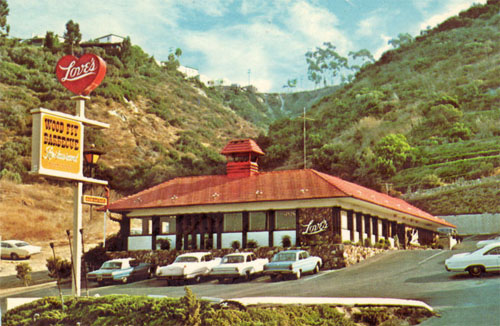
There was a time when Love’s Wood Pit Barbecue restaurants dotted the California landscape and seeped into other states, as well. Some folks believe it’s impossible to get decent barbecue in a chain. You need a small, one-of-a-kind restaurant in a building that used to be a welding shop and was converted by some guy who’s obsessive about good bbq and has been doing it all his life. I’ve been to some great places that fit that description and also some where the food was close to inedible.
Love’s fell somewhere in-between but they were always conveniently located and there are times you need to eat and you can’t find one of the “other” kind of bbq joint, or maybe you’re just not in the mood to gamble. Love’s had decent ribs, great chicken, terrific sandwiches and easily the best beans I’ve ever had in my life. I used to go to every Love’s I ventured near and for a time, I had a running correspondence with a gent who was either the president of the company or very close to that. Each time I ate at a new (to me) Love’s, I’d send him a critique. He’d write me back a nice letter and toss in coupons for free meals. A fine relationship.
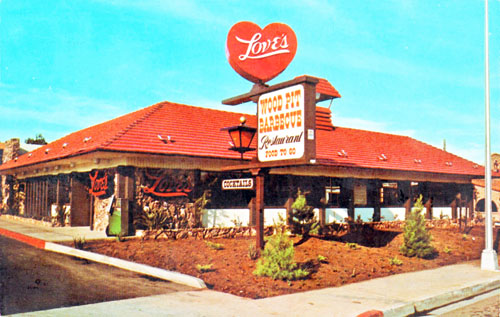
But I liked Love’s for other reasons beyond the coupons. They were friendly and dependable and the food was pretty darned good. So you could often find me at the one on Pico Boulevard near Beverly or at the one on Hollywood Boulevard at Cherokee or at the one in Encino or the one in Pacific Palisades or any other one. I probably went to twenty different Love’s including the one Love’s Junior they operated (briefly) on Ventura Boulevard in Van Nuys. It was an attempt to repackage their cuisine into something that functioned like a fast food outlet. Had that experiment succeeded, I assume we’d have seen them in locations too small to handle a full-sized Love’s or in food courts.
Alas, over the years the chain just lost business and got smaller. The one on Pico, which had once been a kind of “flagship” Love’s and was used as a model and training facility for others, turned mysteriously one day into a place called Noonan’s. Noonan’s was the name of the company that supplied uncooked ribs to many L.A. restaurants and they went into business in some kind of partnership with Bob Morris, who had founded R.J.’s for Ribs, Gladstone’s and other popular Los Angeles restaurants. (Morris now operates the Paradise Cove Beach Cafe in Malibu, which is not covered on this site because it’s open and thriving.) Then it became Bob Morris’ Beverly Hills Cafe even though it wasn’t really in Beverly Hills…and it may have changed names one or two more times before closing down. The building is now the office of a limousine company. The Love’s on Hollywood Boulevard changed identities at least ten times and is now a restaurant called the Geisha House.
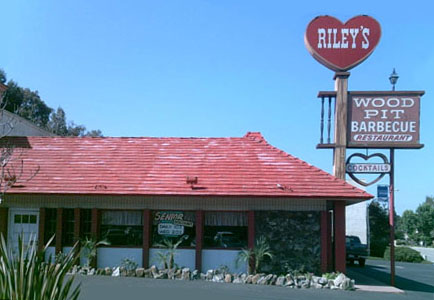
There were some changes of ownership and some lawsuits in the Love’s operation. A lot of them closed and the ones that didn’t changed names. The Love’s in Brea, for instance, changed its name to Riley’s and went on serving the exact same menu for years. The one in Chula Vista renamed itself The Great Rib Restaurant, which was a subtitle that Love’s sometimes used in its advertising and on its signs. Eventually, all such after-life Love’s closed. According to the company website, there’s still a Love’s in Jakarta, Indonesia but I’m skeptical that’s so. If it exists, it’s the only one.
Folks who loved Love’s still love it…and miss it. If you do some Googling, you’ll find a number of different recipes that purport to be the secret to replicating Love’s Beans and others that teach you how to make the sauce. Since the recipes differ, some or all of these are obviously wrong. I haven’t tried making any of them but the recipes for beans (which is sometimes attributed to the L.A. Times) strike me as dead wrong. Some of the sauce recipes seem credible, especially this one…
2 cups cider vinegar
3 1/2 cups brown sugar
2 tablespoons salt
2 tablespoons onion powder
2 tablespoons garlic powder
2 tablespoons celery seed
1 tablespoon black pepper
1 tablespoon paprika
2 tablespoons lard
1/4 cup pickling spicesPlace lard (not shortening) in a pot. Add sugar and then other ingredients. Cook over a low flame stirring occasionally until sauce reaches the desired consistency.
As I said, I never made this but it sounds like it might be the secret. And the reason I’ve never made it is that every three or four years, I order another case of the genuine article from the Love’s website. I have no idea why they’re still bottling this stuff if there are no restaurants to sell it in. Maybe there is one in Jakarta and it’s thriving. Anyway, it’s been more than two years since I ordered any of it. I don’t guarantee that the site is still active but you can inquire there if you long to get some. As you might imagine from all that brown sugar, Love’s sauce was very sweet but it was awfully good.
Farrell’s
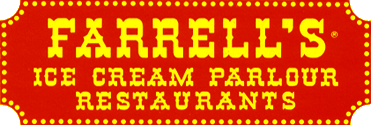
In 1963, Bob Farrell opened the first Farrell’s Ice Cream Parlour. It was in Portland, Oregon and the premise was simple: Serve tons of ice cream in a raucous party environment. People must have liked the idea because by 1970, there were 58 Farrell’s shops and hundreds of imitators. I suspect it was the imitators, with their attempts to out-Farrell’s Farrell’s, that gave that kind of establishment a less-than-good name.
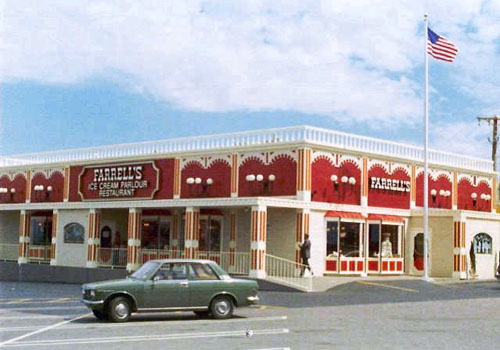
By the time I went to one, it was a place you and your friends would go not so much to dine as to see who could embarrass themselves the most, consuming mammoth tubs of ice cream. One dish was even called the Pig’s Trough. If you finished its twelve scoops, you received a little badge that said, “I made a pig of myself at Farrell’s.” Such an honor. There were also little songs and skits the staff would do in serving the ice cream. One installment of The Bob Newhart Show memorably parodied these, with Bob being humiliated in public over his order of a single scoop. That episode alone probably scared a lot of people off from visiting a Farrell’s. At the very least, it summarized why I never felt too comfy in one.
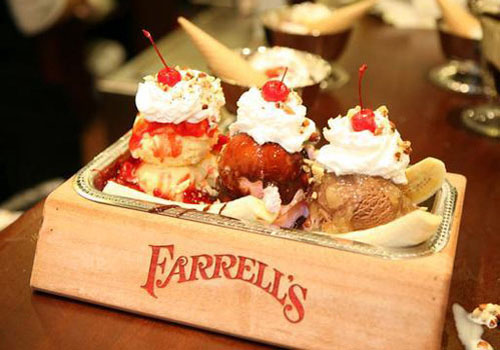
Mr. Farrell sold the chain to the Marriott Corporation in 1971 and worked with them to expand its reach to 130 parlours across the nation. It is said that every one was successful, at least while Mr. Farrell was involved, but then it all went wrong in a hurry. He left the company and soon after, in 1985, it was sold. The new owners decided the concept had run its course (perhaps it had) and began to play down the “make a pig of yourself” theme and turn the chain into facsimiles of Howard Johnson’s — family restaurants with a great ice cream capability. By 1990, the chain was almost dead. In ’96, a new company acquired the name and trademarks, and has been slowly opening new Farrell’s here and there. In this era of more conscious healthy eating, it’s probably not the same.
Lobster Barrel
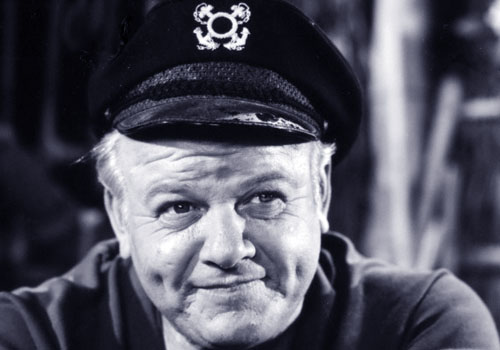
North of Restaurant Row, in a building that now houses something called The Shark Bar, there was a seafood restaurant owned at least in part by “Skipper” Alan Hale from the TV series, Gilligan’s Island. I believe The Lobster Barrel was a small chain in nearby cities at the time and that Hale arranged to buy into the one on at 826 N. La Cienega Boulevard and they then plastered his name and face all over it. Unless acting work kept him away, he was always there to greet people, show them to their table and pose for snapshots. At each place setting, there was a large color postcard bearing a portrait of the Skipper. If you looked at all like a first-timer, he would seat you and then without being asked, autograph the postcard to you. He also sold (or sometimes gave away) skipper hats like the one he was always wearing.
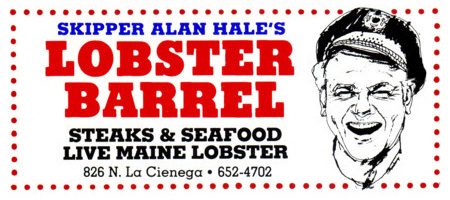
I only ate there once and was a bit overpowered by Mr. Hale’s teddy bear friendliness. He called everyone “Little Buddy” and seemed a bit too happy to have us there. Still, you had to admire his spirit. The place had been open for some time before our visit and he didn’t seem tired of all the jokes about Ginger and Mary Ann washing dishes, and was the Professor in the kitchen making the clam chowder and did you have to be Thurston Howell III to afford the full steak-‘n’-lobster combo? I was kind of hoping they’d have something set up where every half-hour or so, one of the interior palm trees would drop a coconut on his head…but no such luck.
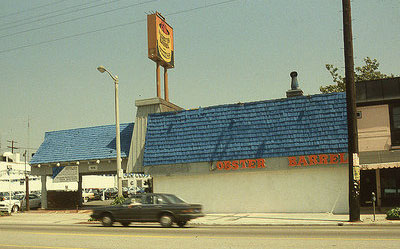
His restaurant was open for fifteen years and then when business slumped, he shut it down and started a travel agency which he ran until his death in 1990. (Would you book a tour through the man who ran the Minnow aground?) About the time the Lobster Barrel closed, Sonny Bono opened a trattoria just around the corner. I guess starting a restaurant in that neighborhood is what you’re supposed to do when you’re on CBS, your show gets cancelled and your former partner goes on to other projects without you.
M’Goo’s
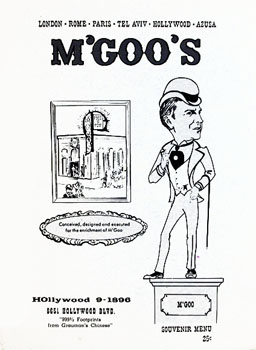
There were at least three M’Goo’s Restaurants — one in Pasadena serving the Cal Tech crowd, one in Westwood Village serving the U.C.L.A. crowd, one on Hollywood Boulevard serving transients and derelicts, some of whom had once been in the Cal Tech and U.C.L.A. crowds. All seemed dedicated to the proposition that pizza is best enjoyed when the music is so loud it makes the pepperoni curl. These were “party” places that I gathered had once been exclusively in Gay 90’s decor but by the time I visited the two I visited (Westwood and Hollywood), someone had given up and haphazardly slapped modern posters and decorations on top of the classic ambiance.
My memories of the few times I could stand to be in them is that they had sports on the TV, silent movies running on a screen and a music system cranked up way beyond Spinal Tap’s infamous 11. As if that and the mediocre pizza didn’t send you babbling into the streets, employees wearing straw hats would occasionally leap up onto the tables and lead everyone in singing a song other than the one currently coming through the speakers. Some claimed that if you listened hard, you could hear the sound of one M’Goo’s at both of the other M’Goo’s. They’ve all been defunct for several decades and I’m not sure I still don’t catch the occasional echo.
C.C. Brown’s
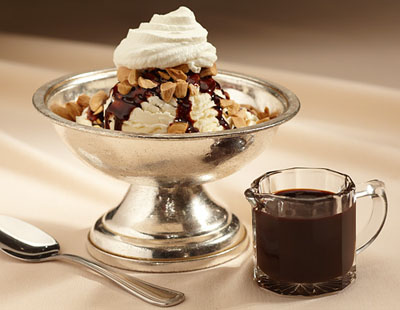
I’m always suspicious of restaurants that claim to have invented some item that you now find on menus everywhere. In Philadelphia, there are at least three places that will swear to you the Philly steak sandwich was first served on their premises, and there are two in L.A. alone (Phillipe’s and Cole’s Pacific Electric Buffet) that insist they originated the French Dip.
Legend has it that the hot fudge sundae was the creation of one Clarence Clifton Brown, serving patrons a dish of ice cream with a little apply-it-yourself flask of molten chocolate. This supposedly occurred in his parlor in downtown L.A. in 1906. In 1929, his son Cliff moved the business to 7007 Hollywood Boulevard, just down the street from Grauman’s Chinese Theater. There it stood for decades, serving sundaes to celebrities and to tourists who came by to watch the celebrities eat sundaes. Its lush interior — mahogany booths with pink leather seats — was seen in several movies including Minnie and Moscowitz.
I went there the first time as a kid in the mid-sixties and the sundae was delicious but a bit of a disappointment. From all I’d heard about it in advance, I was expecting something that would put your basic Baskin-Robbins sundae to shame…and the one at C.C. Brown’s was only marginally better. Which is not to say it was anything but delicious. I just imagined the world’s greatest hot fudge sundae, as I’d long heard it was, would do something more than just taste good.
The establishment on Hollywood Boulevard finally closed in 1996, its final days marked by a stampede of patrons who acted like they might never taste a decent hot fudge sundae again. The company seems to still exist, franchising the name and selling fudge and yogurt and (I think) ice cream, as well. In many a restaurant, you can still find the assertion that they’re serving a C.C. Brown hot fudge sundae indistinguishable from the original…but I’ll bet most of those places microwave the fudge.
Woody’s Smorgasburger
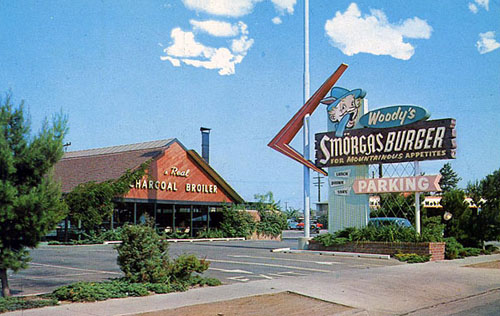
It was sad when they turned the last outpost of Woody’s Smorgasburger, down on Sepulveda just South of LAX, into an International House of Pancakes. Lo, how the mighty have fallen. In the sixties, there were Woody’s all over California, including a wonderful one in Westwood Village, a block or three from U.C.L.A., where I could often be found between (and once in a while, even during) classes. Woody’s was the first chain I know of where you could get a hamburger and then carry it over to a little self-service counter stocked with ketchup, mustard, onions, pickles, salsa, barbecue sauce, etc., and do whatever you wanted to it. Today, there are chains aplenty like Fuddrucker’s that offer this but at the time, it was something rather special.
Woody’s burgers were pretty darn good too, with a nice barbecue flavor…and every Woody’s also had a “make your own sundae” bar: You could get an empty dish at the counter, fill it full of soft-serve vanilla ice cream, then slather it in a diverse selection of syrups and sprinkles and crushed nuts and such. My old comic club buddies and I would practically have a contest to see how much sundae we could get in one dish, building structurally-unsafe vertical arrays, then trying to walk them back to the table and devour the top stories before it all collapsed.
One of the guys once asked if he was allowed to put the toppings from the sundae bar on his burger or vice-versa. When they told him yes, he began speculating on what hot fudge or whipped cream would do to a hamburger, and whether the maraschino cherries would blend with the mustard or if he should leave the mustard off. Each visit to Woody’s, he’d say, “Next time, I’m going to try it,” but he never worked up the courage. Or wanted to spoil a good smorgasburger.
Zito’s
A couple of years ago, I was asked to contribute an essay to an online survey of “My most memorable meals.” I decided to write about Zito’s and to write this…
My most memorable meals would probably have more to do with who was across the table than what was on it. Get the right dinner companion and a two-fer coupon at Arby’s can yield a more memorable event than Passover with Wolfgang Puck.
But, looking just at what was on the plate, I can’t help but think of the best Italian restaurant of my childhood — Zito’s, which was on Pico Boulevard in West L.A., two blocks west of Westwood. Mr. Zito ran the business end and Mrs. Zito was in the kitchen, whipping up a dark, brown meat sauce, the likes of which I’ve yet to encounter. It was rich and obviously cooked slow and long…and if I knew what it contained, I wouldn’t be writing this, I’d be downstairs whipping up a batch.
Zito’s went out of business in the seventies and, since then, I trek from Italian restaurant to Italian restaurant, searching for anything even vaguely like Mama Zito’s masterwork. I’ve had some fine meals in my quest but, so far, no success in locating a clone. (Sometimes, when I sit down to plate of spaghetti in some obscure town I’ll never again visit, I am of two minds: I, of course, hope the meal will be wonderful…but what if I find a sauce comparable to Zito’s in a dive well off the Interstate in Jerkwater, Michigan? When am I ever going to be back there? How will I drag friends to that wonderful restaurant?
So far, this has not been a problem because I haven’t found it. I’ve also looked closer to home and haven’t found it there, either. Zito’s building stood empty for a year…then another Italian restaurant moved in. It was and is named Anna’s and, of course, I went there and found perfectly fine Italian food. But not like Zito’s.
I asked the operators of Anna’s and they told me that Mr. and Mrs. Zito had both passed away, as had the other members of the Zito family. They knew because I wasn’t the first Zito’s patron to inquire. Some had even (apparently) called representing major food corporations, hinting there might be Big Bucks if someone could come up with the recipe for Zito’s meat sauce. Alas, no one could.
I told this story once to a restaurant critic. To my surprise, he said, “It’s just as well. The recipe probably wouldn’t have yielded the same results in someone else’s hands.” Good food, he explained to me, can be created from a good recipe…but great food is a function of the person who prepares it. In other words, the secret ingredient in Mrs. Zito’s sauce was Mrs. Zito. She spent all day making it, no doubt, stirring it, tasting it, adding a pinch of this or a dash of that. “It’s like painting,” he explained. “I can tell you what color to paint a vase of flowers but that doesn’t mean you’re going to produce a Van Gogh.”
I’m afraid he’s right. How sad to think that Mrs. Zito took my favorite meal with her to the grave. On the other hand, I’ll bet God’s eating well.
Since I wrote this, Anna’s has closed down and will be the subject of another post here.
Zucky’s Delicatessen
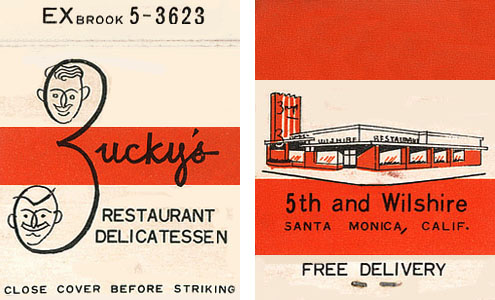
Zucky’s Deli was located out at the corner of Wilshire and 5th Street out in Santa Monica and as I write this, it still is. At least, the building is. It’s been empty since 1993 while the owners of the land and others who consider the place an example of significant historic decor discuss what to do with the place. This strikes me as an odd discussion. I don’t recall the architecture and design being that special and the food certainly wasn’t.
Opened in 1954 by Hy and Frederick Altman, it was named for Hy’s wife, whose maiden name was Wolfine Zuckerman. She was often called “Zucky,” as if it rhymed with “rookie.” I did not know that during the years I dined at Zucky’s but I know that now.
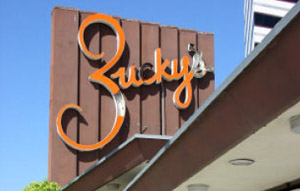
The main (for me, only) appeal of Zucky’s when I used to go there was that it was open 24 hours so it was a great location to take your date for ice cream or a snack after you took her to one of the movie theaters out on Third Street. It was also “the” place for breakfast and sometimes lunch for folks who worked in Santa Monica. It struck me as a restaurant that wasn’t very good but it drew a crowd for lack of alternatives. When better places to eat opened in the neighborhood, Zucky’s floundered. I have some fond memories of going there but because of the people I was with, not because of the business establishment.
Piece O’ Pizza
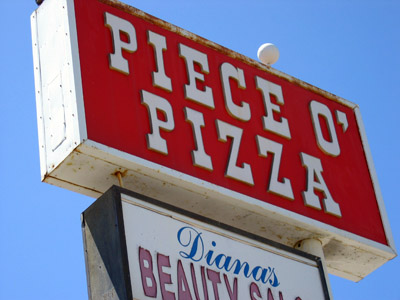
Piece O’ Pizza was the brand name of a string of eateries that once decorated the Southern California landscape…an amazing reach considering the awfulness of their signature product. Do you like pizza where the crust tastes like matzo, the toppings have the thickness of carbon paper and you can’t decide whether to eat the pizza or the box it came in? If you do, you’d have loved Piece O’ Pizza pizza. Just awful. What kept them in business, it seemed to me, was their great, racy slogan (“Had a piece lately?”) and the fact that there then weren’t a lot of other places where one could grab a fast pizza to take home.
Also, they served a decent meatball sandwich and a more-than-decent (and very cheap) spaghetti plate. Many of the Piece O’ Pizza stands were in “Skid Row” style areas, and I bet that spaghetti plate kept a lot of homeless people alive.
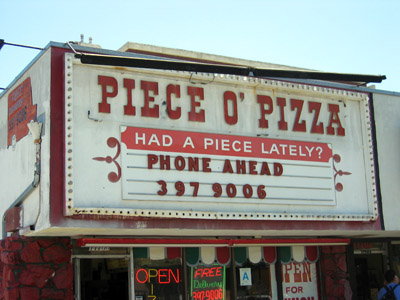
Like I said, they were all over L.A. There was one on Pico just east of Sepulveda, one at Beverly and Fairfax, another on La Brea just south of Hollywood, another on La Cienega near Airdrome, another on Western just south of Hollywood…and (I’m guessing) at least 200 more. As far as I know, there’s only one remaining. It’s down on Venice Boulevard about a half-mile west of Sepulveda. A year or two ago, I was in the neighborhood and in need of rapid lunch, so I decided to go in and have the spaghetti plate, just to see if it was still the same. Since there is no parent company now to supply the preparations, I was expecting totally different cuisine…but the meat sauce was more or less what I recalled, or at least it seemed to have evolved from the same recipe.
I probably won’t go back since I now have better places to eat. I suspect that’s what killed off the Piece O’ Pizza chain in or around the late eighties. As Numero Uno and Pizza Hut and even Domino’s spread, everyone had a better place to get a quick pizza or to have one brought piping-hot to their door. Speculating further, I’d guess that too many of their stands were located in depressed areas, which made it difficult for them to upgrade their product. It would have been awkward to simultaneously improve their menu (thereby making most items more expensive), advertise that they’d done this…but still service the crowd that just wanted the cheapest-possible plate of pasta.
I don’t exactly miss the places since they weren’t that good. On the other hand, I’ve been to fancy Italian restaurants where I enjoyed a $20 entree a lot less than I liked the Piece O’ Pizza spaghetti plate. Even in the early eighties, it didn’t cost much over two dollars…and that included garlic bread.
A&W Root Beer
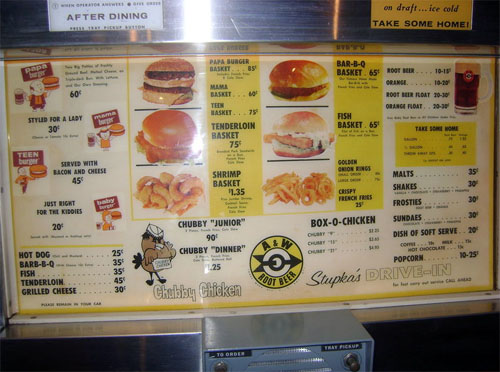
A&W Root Beer still has a thriving presence in the fast food world but as with so many dining landmarks of the past, it ain’t the same. For one thing, they’re no longer drive-ins, at least in California. The last one in the state, which was located way out in Ontario, closed on April 30, 2006. No more car hops bringing you trays of burgers and A&W Root Beer.
When I was a kid, there were two kinds of A&W dining establishments in Los Angeles — the drive-in restaurants and the stands. The stands seemed to be located primarily in the rotten parts of town. As I was then prowling Los Angeles second-hand bookstores in search of old comic books, I often found myself near one. They were cramped little hot dog and burger stands, usually manned by one employee. For a nickel, you could get a frosty cold mug of root beer — and it was a real glass mug, not a paper cup. They also had a pretty good orange drink which cost a dime and which almost no one ordered. I never understood why the orange drink was twice the price of the root beer.
In classier neighborhoods, you had the drive-ins. I remember one out on Santa Monica Boulevard in Santa Monica and another on Sepulveda just south of Venice Boulevard. The standard meal was a burger, fries and root beer. They had Coke and 7-Up and milk shakes but if you asked for one of those, the order-takers acted like you were the first person ever to not want the root beer. The burgers ranged in girth from huge to a kid’s size called the Baby Burger. Some adults liked to order several Baby Burgers and wolf them down like White Castle slyders.
The main thing I recall about drive-in restaurants is how utterly awkward it was to eat a meal that way. The server would bring your order on a tray that hooked onto your car window. It was not easy to get your food on and off this tray and there was much spillage. A lot of people probably lament the passing of the drive-in but I’ll bet not many of them actually went to them. More than once, at least.
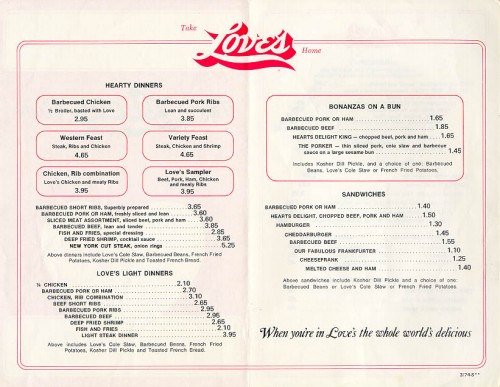






Recent Comments